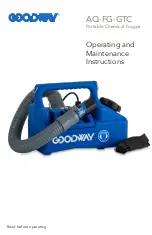
172-65637MA-05 (GP5C PowerTrap) 8 Jun 2020
27
Category
Cause
Procedure
D.
Faulty piping
1. The exhaust is
abnormal
2. The condensate inlet
pipe is too small
3. Not enough pumped
medium is flowing
through the valve on
condensate inlet pipe
• Air-locking or vapor-locking has occurred. The exhaust pipe
is connected to the receiver, but the pumped medium may
not be exchanged for the medium inside the PowerTrap for
the following reasons:
1. There are places that accumulate condensate such as a
U-shaped pipe between the exhaust port and the
receiver
2. The inner diameter of the exhaust pipe or tube is less
than 8 mm (
5
/
16
in)
3. The exhaust plug is not installed properly.
Correct the piping or exhaust plug installation.
For all corrections, refer to
“Installation Procedure”.
• Normal pumped medium flow may not be obtained if the
pumped medium inlet pipe is too small or the valve on the
pumped medium inlet pipe is a needle valve or one with a
small Cv value.
• The pipe and stop valve size must be increased to the
design pipe size, and a full bore ball valve or gate valve
must be used
E.
Faulty
PowerTrap
1. Dirt or scale is
caught in the intake-
exhaust valve or the
valve is worn
2. Dirt or scale is caught
in the intake-exhaust
valve seat or the
valve seat is worn
3. The snap-action unit
is obstructed by dirt
or scale or its
operation is
otherwise faulty
4. The float is broken or
filled with water
• If the PowerTrap does not operate for long periods of
time, in spite of the fact that pumped medium has
collected in the receiver or equipment, if there is no sound
at all of the operating medium flowing in the motive
medium supply pipe/tube and the exhaust pipe/tube, it is
possible that the PowerTrap is faulty.
Note, however, that this phenomenon will also occur
when the motive medium pressure is equal to or less than
the back pressure
• If the PowerTrap does not operate for long periods of time
and the sound of the operating medium can be heard
continuously in the motive medium supply pipe/tube, the
PowerTrap is faulty
Disassemble the PowerTrap, and inspect the following
items:
1. Raise and lower the float and check to make sure the
snap-action unit operates properly
2. Check the intake-exhaust valve and valve seat to make
sure there is no dirt or scale caught or any other
abnormality
3. Check other possible factors that might hinder operation
After performing the above inspection, repair any defects
discovered or replace the PowerTrap
F.
Faulty
check valve
1. Dirt or scale is caught
in the inlet check
valve or the valve is
worn or getting hung
up
• The operating medium that has been supplied is leaking
from the inlet check valve, preventing the pressure inside
the body from increasing; as a result, the pumped medium
is not discharged
Disassembly and inspection is required
2. Dirt or scale is caught
in the outlet check
valve or the valve is
worn or getting hung
up
• The discharged pumped medium has flowed back into the
PowerTrap, causing the interval at which the unit operates to
grow shorter and reducing its discharge capacity
Disassembly and inspection is required
G.
Degradation
or damage
of gasket
and O-ring
1. Damage when
assembling
2. Aging degradation
• When condensate or steam leaks from the PowerTrap,
tighten the bolts with the proper torque or replace the
gasket with a new one.
• When steam leaks into the equipment (to the pumped
medium inlet side) or outlet piping, check the O-ring.



































